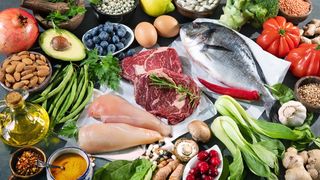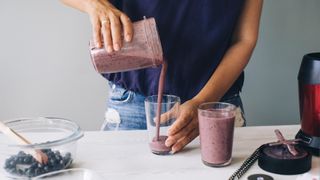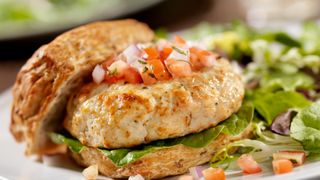
When you purchase through links on our site, we may earn an affiliate commission. Here’s how it works.

If you’re looking for a DASH diet meal plan that makes breakfast, lunch, and dinner straightforward and tasty, you’ve come to the right place.
The DASH diet, which stands for Dietary Approaches to Stop Hypertension, is a way of eating that has been specifically designed by doctors to lower blood pressure and prevent hypertension. This chronic condition affects nearly half of the US population and it can lead to heart disease and stroke.
In many cases, doctors will prescribe the DASH diet to patients who have high blood pressure or are at risk of developing it.
The Centers for Disease Control and Prevention (CDC) defines high blood pressure as being 130/80 mm Hg or higher. This means the systolic blood pressure (the pressure in your arteries when your heart beats) is greater than 130 mmHg while the diastolic blood pressure (the pressure in your arteries when your heart rests between beats) is greater than 80 mmHg.
But if you don’t have high blood pressure and are just looking for a healthier way of eating for general wellness, the DASH diet is also used for weight management.
Whatever your reasoning for trying the DASH diet, getting started can be overwhelming. So use this simple seven-day DASH diet meal plan to make this way of eating an easy and delicious way of life.
According to Erin Kenney, Registered Dietitian and CEO of Nutrition Rewired, “the DASH diet is rich in vegetables, fruits, and whole grains.” It also includes fat-free or low-fat dairy products, fish, poultry, beans, and nuts. The DASH diet limits foods that are high in saturated fat, which includes fatty meats and full-fat dairy products.
This way of eating puts an emphasis on getting plenty of dietary fiber and limiting sodium intake because too much salt is bad for you. High-fiber foods include fresh fruits, including apples, bananas, berries, and stone fruit. It’s best to limit high-sugar fruits such as canned, in-syrup or dried. Vegetables like leafy greens, broccoli, carrots, and cauliflower are also high in fiber, as are whole grains like quinoa, farro, brown rice, and barley.
You can enjoy dairy on the DASH diet, but it’s important to reach for low-fat options, such as skim or 1% milk and low-fat yogurt. Likewise, with meat and poultry, lean, skinless chicken breast, pork tenderloin, lean ground beef, and seafood are great options. Avoid processed deli meats, which are often full of sodium.
Packaged snack foods, such as crackers, chips, and cookies, also tend to be high in sodium, sugar, and refined oils and low in fiber. Check the nutrition labels to manage your daily sodium intake.



When following the DASH diet, the goal is to reduce sodium intake to improve overall blood pressure. Another important factor in blood pressure control is your hydration level. It’s important to drink an adequate amount of water every day. According to the US National Academies of Sciences, Engineering, and Medicine, adult men should consume about 15.5 cups of liquids a day, and women should drink about 11.5 cups per day.
In addition to proper hydration, you’ll want to avoid foods and drinks that can dehydrate you. For example, alcohol and caffeine are both diuretics, which can cause dehydration. Highly processed foods, which tend to be high in sugar and salt, can also increase the risk of hypertension.
Instead of processed foods and red meat, aim to eat more whole produce and whole grains. It’s important to eat plenty of dietary fiber in the form of fruits and vegetables. These not only improve digestion and blood sugar, but they also help you feel more full during and after meals, so you’re less likely to overeat or reach for high-salt or high-sugar foods.
Get the world’s most fascinating discoveries delivered straight to your inbox.
By submitting your information you agree to the Terms & Conditions and Privacy Policy and are aged 16 or over.